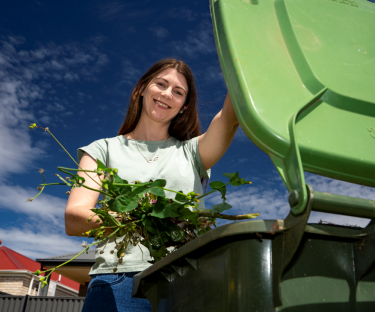-
Home
- Kitchen to Compost
Kitchen to Compost
We often hear people think it doesn’t matter which bin you put your waste into. If you knew how untrue that is, and how easily you could make a real difference, you would likely be happy to make some small changes.
If you have a green FOGO (Food Organics, Garden Organics) bin in Playford you’re one of around 20,000 people who do, and you’re in a prime position to help make some real change with your treatment of household food waste.
Our residents with FOGO bins do a pretty good job of using the bin to dispose of garden waste, but currently, there is too much food waste going into the red bin (around one third of the contents) which ends up in landfill – and that’s a double loss.
The first loss is environmental; food waste in the red bin goes to landfill where it off-gasses into greenhouse gases which is bad for the environment. If it goes into the green bin it is processed to create rich compost to use in our soils, which is great for the environment.
The second loss is financial; processing food waste is considerably more cost efficient when it goes into the green bin than the red.
So ANY piece of food you divert to your green bin is going to make a huge difference! You can make sure fruit and vegetable scraps, paper towels, tissues, oily cardboard such as pizza boxes, meat waste, citrus peels, and even pet poo never end up in landfill. This simple change of routine by green bin users can make a significant impact in our community. The power is in your hands!
So what else goes into the FOGO bin?
As a general rule of thumb, remember the saying 'if it grows, it goes.' In other words, if it was once 'alive' then it's good to go into the FOGO bin!
- Any food waste
- Egg cartons
- Pet poo
- Tree cuttings and lawn clippings
- Hair and nail clippings
- Pizza boxes, cardboard and paper (they're compostable because they were made of trees - which grow!)
- Pencil and wood shavings (ditto)
- Old flowers
- Fallen leaves
- Coffee grounds and used tea leaves
To find out more information about what does and doesn't go into your green bin visit: https://www.whichbin.sa.gov.au...
Helpful tips on how to go from ‘kitchen to compost’:
- Make it as easy as possible - keep a kitchen caddy (or an old ice cream container) on your kitchen counter so when you're peeling veggies, or clearing dishes of uneaten food before doing the dishes, it will be easy to discard the food into your caddy rather than putting it into your general waste bin.
- Line the caddy or container with paper towel or newspaper - this helps to soak up additional moisture. You can also use compostable bags (you can purchase them online or from Woolies), but make sure they're 100% compostable, not just bio-degradable, and do not put plastic bags in your caddy - they can't go into the green bin. All compostable products have the seeding logo.
- When the caddy is full - or if it's starting to smell unpleasant - it's time to take it out. It should go out more regularly than your general waste bin. Depending on the size of your family it may go daily or two or three times a week. Food scraps can go into the green bin loose, wrapped in newspaper, or enclosed inside a compostible bag - but never in plastic or polystyrene. Rinse out your caddy after it's emptied and re-line it ready for its next meal!
- It's possible to reduce the smell in your green bin by adding layers of aerated organics; ie; use pizza boxes in between 'wetter' organic matter - this inserts a layer or a pocket of air which helps to reduce the smell. You can also put in a layer of newspaper - tear it into strips and drop it in untidily rather than just throwing the whole newspaper in as is. You can also use dry lawn cuttings on top of more smelly contents - but make sure the grass is dry, green or wet lawn cuttings won't have the same effect.
- If you have some particularly smelly food scraps (ie; prawn heads and shells), we recommend you wrap them in newspaper and freeze them - and put them in your green bin the night before your collection date.
Residents can purchase a FOGO green bin for $57. Get in touch with NAWMA online at www.nawma.sa.gov.au or by phone on 8259 2100.

 Putting the play in PlayfordPublished 4 October 2022As part of Council’s commitment to building an active and connected community, this year we plan to build new parks, renew existing reserves and revamp recreation infrastructure all over the city.Read full article
Putting the play in PlayfordPublished 4 October 2022As part of Council’s commitment to building an active and connected community, this year we plan to build new parks, renew existing reserves and revamp recreation infrastructure all over the city.Read full article Champs in action this OctoberPublished 29 September 2022This summer, the pros will be returning to the Playford Tennis Centre at Elizabeth East with the City of Playford Tennis International.Read full article
Champs in action this OctoberPublished 29 September 2022This summer, the pros will be returning to the Playford Tennis Centre at Elizabeth East with the City of Playford Tennis International.Read full article A centre for community connectionsPublished 28 September 2022Now boasting over 150 speciality shops and a bustling entertainment precinct, the Elizabeth City Centre’s role in Playford has always been more than that of your typical suburban shopping mall.Read full article
A centre for community connectionsPublished 28 September 2022Now boasting over 150 speciality shops and a bustling entertainment precinct, the Elizabeth City Centre’s role in Playford has always been more than that of your typical suburban shopping mall.Read full article The nitty gritty of growthPublished 7 September 2022It’s no secret that Playford is growing. For the past couple of decades, scores of new housing developments have popped up across the city and we’ve welcomed thousands of new residents into our community each year.Read full article
The nitty gritty of growthPublished 7 September 2022It’s no secret that Playford is growing. For the past couple of decades, scores of new housing developments have popped up across the city and we’ve welcomed thousands of new residents into our community each year.Read full article Green light for organics.Published 16 February 2022If you own a green bin in Playford, you’re in a great position to fight food waste. Just over 30 per cent of the contents of our red lid general waste bins in Playford are comprised of food scraps, which ends up in landfill.Read full article
Green light for organics.Published 16 February 2022If you own a green bin in Playford, you’re in a great position to fight food waste. Just over 30 per cent of the contents of our red lid general waste bins in Playford are comprised of food scraps, which ends up in landfill.Read full article







